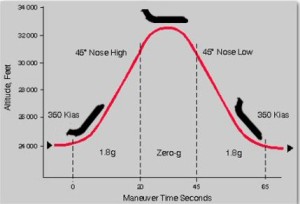I first heard of the band OK Go when they released their music video for ‘Here It Goes Again,’ which features the band members cruising back and forth over treadmills. I soon discovered that many of their other music videos are equally captivating and involve cool applications of physics. For example, their video for ‘This Too Shall Pass’ involves an elaborate Rube Goldberg machine, a complex device designed to perform a simple task. This is the same type of device the kids use in ‘The Goonies’ to open the gate for Chunk.
A few weeks ago, they released the video for their song ‘Upside Down & Inside Out,’ which might be the most fun so far. This video involves the band members floating about in an airplane like astronauts. Go ahead and watch it, then continue below and I will explain some of the physics behind the video.
How They Did It

First of all, the members of OK Go are not in space or in zero gravity. They are in a plane flying at altitudes similar to commercial aircraft. This plane, however, flies in parabolic trajectories, as shown in the figure, to simulate weightlessness within the plane. NASA has a similar plane called the Weightless Wonder to help astronauts train and perform science experiments. The figure to the left shows how this works. As the plane starts to fly higher, everything on board feels heavier than normal (0-20 seconds in the image). Once the plane reaches a certain altitude, the pilots slow down the engines and the plane begins to move only under the influence of gravity (20-45 seconds in the image). This is just like what happens when you throw a ball into the air. You apply a force to throw the ball, but once it leaves your hand, it moves only under the influence of gravity. It goes up a little ways before coming back down.
In the OK Go video, the people and objects inside the plane are like the ball thrown into the air. But since the people are moving at the same rate as the plane, it simulates weightlessness. You do not feel this way when you skydive, for example, because you can feel the air pushing on you as you fall down. Inside the plane, however, you feel weightless because the air is falling at the same rate as you.
Typically, these parabolic trajectories that create weightlessness can only last up to about 30 seconds. For a song that is 3:21 long, this means OK Go had to shoot the video in multiple segments and then edit it to make it look smooth. You can see that at certain times everything falls to the floor of the plane (most obvious at 2:03, 2:27, 2:46, and 3:08). At these moments the plane is coming out of the parabola so gravity is, in a way, turning back on. OK Go released a short video describing some of the challenges they faced filming in this type of environment and how they solved those problems.
Other Neat Physics
This whole video is full of great examples of introductory physics; I bet many teachers are already writing questions based on this video. Here are three of my favorite parts of this video from a physics point-of-view.
- One of the coolest visual aspects of the video is at 2:51 when the balloons full of paint appear. The band members start popping the balloons and paint goes everywhere. On Earth, if you pop a balloon full of anything, the contents are going to fall straight down to the ground. But in weightlessness, the direction the paint goes depends on a few things.
The lead singer first pops a purple balloon with orange paint that he holds in his hand. He takes his finger, pushes almost straight down to pop the balloon and the orange paint moves upwards. It moves up because of the conservation of momentum. Since the balloon is stationary and his hands moves downwards, the paint goes up. In the same situation on Earth, the paint would try to go up as well. But the effect of gravity is strong enough to overcome this motion and would force the paint to fall to the ground.
You have experienced something similar to this if you have ever tried to push someone while rollerblading or ice skating. If you are standing still and give someone a push, you will start moving the opposite way. - At 1:38 the flight attendant in front starts spinning with her legs out before bringing them in and spinning more quickly. She is conversing her angular momentum, which is exactly the same thing ice skaters do when they spin. If you are spinning and have your arms out you will spin faster when you bring them in, and vice versa. You can do this in most office chairs too, but it is helpful to have a friend spin you.
- Disco balls are released around 2:37. You can see a couple of them bouncing off each other and all of them hit the walls of the airplane. Just like in the game of pool, the direction they each travel depends on the speed and direction of the collision. Calculating the trajectories of pool balls is a common physics question. Calculating the trajectories of the disco balls would be a fun extension of that.
Like most OK Go videos, this one took a lot of work to put together. They have released a few videos detailing how it all came together. This band keeps finding ways to include great physics demonstrations in their videos.
Peer edited by Kayleigh O’Keeffe & Ashley Fuller
Follow us on social media and never miss a blog